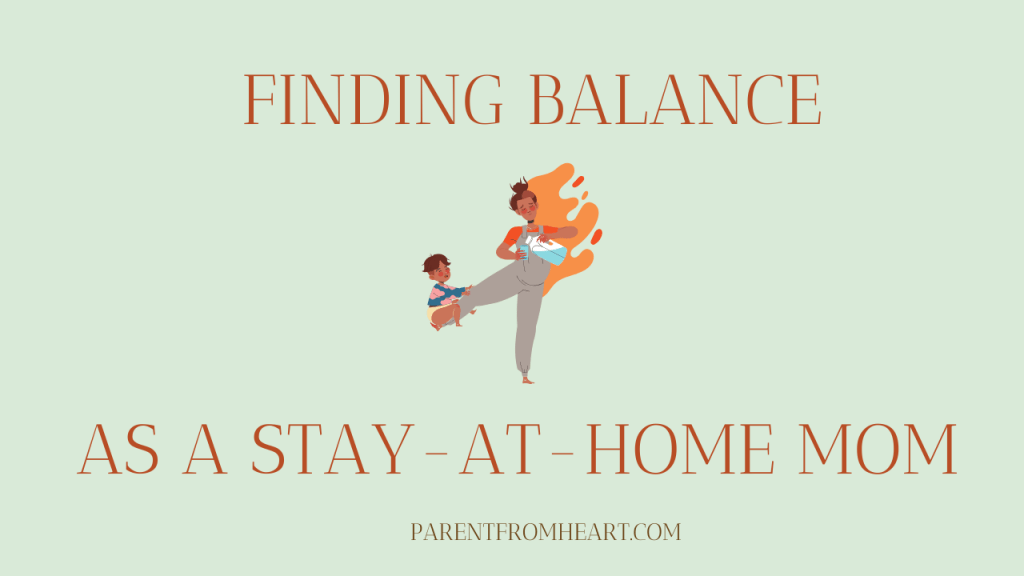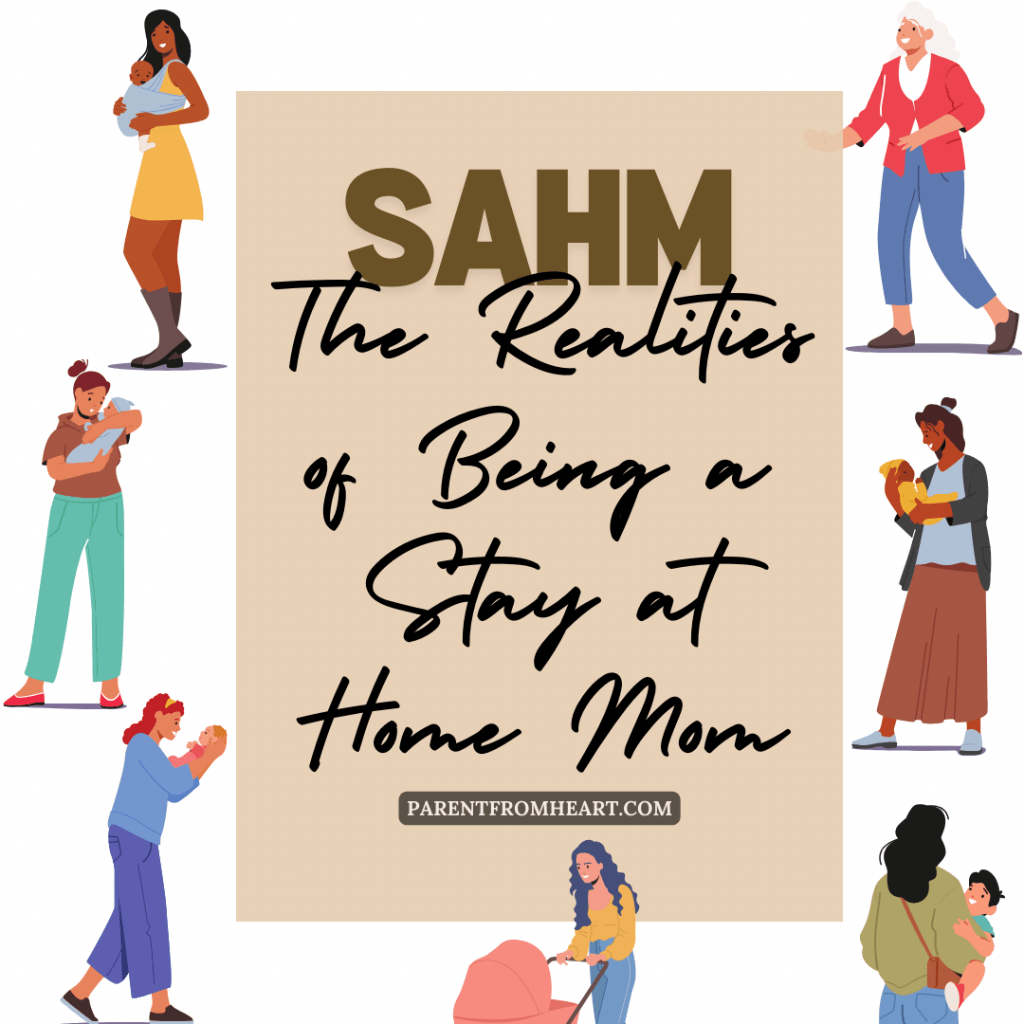Table of Contents
I thought pregnancy and childbirth were difficult. However, nothing prepared me for the challenges of being a stay-at-home mom (SAHM).
Being a SAHM means taking on the primary caregiver and household manager role. It also entails managing the emotional and physical needs of your child(ren) while caring for yourself in multiple ways.
SAHMs work 24/7 with no breaks or sick days. In other words, it’s a lifestyle reserved for the brave and resilient. But despite the challenges, being a SAHM has its rewards. Here are some of its realities and joys.
The Realities of Being a Stay-at-Home Mom

First of all, let’s break down the three major realities of being a SAHM:
Daily Routine and Structure

As a SAHM, your day revolves around the needs and schedules of your child(ren). Most often, it also involves your partner’s and, of course, your own. This means being up at the crack of dawn to prepare breakfast, get the kids ready for school or playdates, and tackle household chores. And let’s not forget about meal planning and grocery shopping.
It’s unlike in an office setting where you have designated breaks and time off. Instead, there are no such things as “lunch breaks” or “clocking out.” Your schedule will constantly change and adapt to the needs of your child(ren). Not to mention, there’s always a possibility of interruptions and unexpected events that may throw off your daily routine.
Breastfeeding mothers’ daily routines gradually emerge, with some establishing hints of structure by 6-8 weeks and a more defined routine by 10-12 weeks.1
Emotional and Mental Health

Motherhood comes with a plethora of emotions.2 Being a SAHM means experiencing all the highs and lows of motherhood in full force. One moment, you’re overwhelmed with joy watching your child take their first steps, and the next, you’re frustrated and exhausted from dealing with tantrums.
Add in the isolation and lack of adult interaction, and it can take a toll on your mental health. In my case, putting my career on hold and solely focusing on my children left me feeling unfulfilled and questioning my identity outside of being a mother. So, this area requires a lot of self-care and finding ways to maintain a sense of self.
Approximately 10-20% of new mothers worldwide experience postpartum depression, which is one among several forms of postpartum mood disorders, including anxiety disorders and, rarely, postpartum psychosis.2
Social Perception and Pressure

There’s a huge stigma attached to being a SAHM, especially now, where women are encouraged to have successful careers and “have it all.”3 Being a SAHM may be seen as taking the easy way out or not contributing enough to society. It can also lead to feelings of guilt for not financially contributing to the household.
On the other hand, there’s also pressure from the outside world to be the perfect SAHM. Society expects you to have a perfectly clean house, well-behaved children, and daily home-cooked meals. SAHMs should deprive themselves of any free time to focus solely on their children’s needs. These unrealistic expectations can lead to feelings of inadequacy and constant comparison with other mothers.3
Pregnant women often face discrimination in the workplace, including biases related to competence and commitment.3
Things to Consider About Being a SAHM

I hope I haven’t scared you away from considering being a SAHM. Because despite the challenges, it also brings immense fulfillment and joy. However, before taking the plunge, here are some things to consider:
- Financial stability: Can your family afford to live on one income? Will you need to make adjustments to your budget? How will you save for retirement?
- Your mental health: Are you prepared for the potential isolation and lack of adult interaction? Do you have a support system in place? How will you prioritize self-care?
- Your career: Are you willing to put your career on hold? Are you willing to change career trajectories? If so, are there options for returning to the workforce in the future?
- Your identity: How will you maintain a sense of self outside of being a mother? What hobbies or interests can you pursue while being a SAHM?
Think carefully about these factors and discuss them with your partner before deciding. Remember, being a SAHM is not the only way to be a good parent. Every family’s situation is unique, and what works for one may not work for another.
Benefits of Being a Stay-at-Home Mom

As mentioned, being a SAHM has many benefits. And contrary to popular belief, not all stay-at-home moms are unhappy.4 Here are other benefits to being a SAHM: 4,5
- Bonding with your children: As a SAHM, you have the opportunity to spend more time with your children during their formative years. This can lead to stronger bonds and deeper connections, as 60% of Mericans believe.
- Flexibility: You have more control over your schedule as a SAHM, which can be helpful for managing appointments, school activities, and other household responsibilities.
- Contribution to the household: By taking on the responsibility of managing the home and caring for the children, you are contributing significantly to your family’s well-being. This can bring a sense of purpose and fulfillment.
- Personal growth: Being a SAHM requires patience, resilience, and multitasking skills. It can also challenge you to find creative solutions and develop new skills, leading to personal growth.
- Reduced childcare costs: By staying home with your children, you are saving on the high cost of childcare, which can be a significant expense for many families.
- Fulfillment: Many stay-at-home mothers find caregiving fulfilling and valuable, as supported by the finding that most moms under 55 see housework as fulfilling as employment.
Downsides of Being a Stay-at-Home Mom

While there are many benefits to being a SAHM, it’s essential to consider the potential downsides as well. Some of these may include:5,6
- Financial dependence: As a SAHM, you rely on your partner’s income, which can be stressful and limiting if you have always been financially independent.
- Isolation: Being at home with young children all day can be isolating, especially if you don’t have a supportive network of friends or family nearby.
- Lack of adult interaction and mental stimulation: The role of a SAHM can be mentally and emotionally demanding, but it may lack the intellectual stimulation and adult conversations that come with a traditional job.
- Potential career setbacks: Taking time away from the workforce to stay home with your children can lead to career setbacks, such as a loss of professional skills and difficulty re-entering the job market in the future.
- Criticism and societal expectations: Unfortunately, SAHMs may face criticism or judgment from others who believe that staying at home is not a valid or fulfilling role for women. There may also be societal expectations and pressure to “do it all” and balance both motherhood and a successful career.
Finding Balance as a SAHM

I know how it feels to be a SAHM, trying to balance the demands of motherhood with personal growth and self-care. I’ve been one for nine years, and it has been an incredible journey filled with ups and downs.
Challenging days are extra hard, but these tips have helped me find balance as one:
- Schedule “me” time: Make time for yourself, even if it’s just 15 minutes a day. Use this time to do something that brings you joy and helps you recharge, even if that’s just scrolling through social media or reading a book.
- Connect with other moms: Building a support system of other SAHMs can be invaluable. Join mom groups, attend playdates, or even just chat with other moms online. My fellow football moms have been a great source of support and understanding for me.
- Set boundaries: It’s unhealthy to constantly put others before yourself. Learn to say no when needed, delegate tasks, and communicate your needs to your partner or family members.
- Find purpose in motherhood: Being a SAHM may not be the traditional career path many envision, but it is a valuable role in itself. Take pride in raising your children and find purpose in the small moments and milestones.
- Pursue personal interests or hobbies: Don’t lose yourself completely in motherhood. Make time to continue pursuing your passions, whether that’s writing, painting, or exercise. These activities help maintain a sense of self and can bring fulfillment outside of being a mom.
Balancing Motherhood with Personal Goals
- Pursue a career when you can: If you want to pursue a career, don’t let being a SAHM hold you back. There are many flexible and remote job opportunities available that can help you balance both roles. It’s how I found my passion for freelance writing and was able to contribute financially while still being there for my kids.
- Be gentle with yourself: Being a woman is hard enough, and stigmas don’t help. So, give yourself grace when things get tough. Being a SAHM is demanding, and it’s okay to feel overwhelmed or have bad days.
- Find allies. Whether it’s your partner, family members, or friends, having a support system in place can make all the difference. Lean on them when you need to and offer your support in return.
- Don’t compare yourself to others: Every mother’s journey is different. Don’t let social media or societal expectations dictate how you should be as a SAHM. Focus on what works for you and your family, and don’t worry about trying to fit into a certain mold.
- Teach your children the value of hard work: Being a SAHM may not seem like traditional “work,” but it is still valuable and requires dedication and hard work. Use this opportunity to teach your children the importance of work ethic and how to value different types of labor.
P.S. Read Shannon K. Evan’s book “Rewilding Motherhood.” It discusses empowered feminine spirituality, and it has helped me immensely in my journey as a SAHM. I’ve never related so deeply as a mother with a book.
Wrapping Up
Being a stay-at-home mom is full of challenges, but it’s also a rewarding and fulfilling role. As such, do everything you can to care for yourself and find balance in your life. Remember, you’re a mom and a person with passions and dreams.
How has motherhood changed you? What are some of the biggest lessons you’ve learned as a SAHM? Share your experiences and tips with other moms in the comments below! And while you’re at it, pin, save, or share the image below to spread the word and support other SAHMs on their journey.

- Froelich et al. “Daily routines of breastfeeding mothers.” Work, 2015. ↩︎
- Modak et al. “A Comprehensive Review of Motherhood and Mental Health: Postpartum Mood Disorders in Focus.” Cureus, 2023. ↩︎
- Skorinko et al. “Overlapping Stigmas of Pregnancy, Motherhood, and Weight: Policy Implications for Employment and Higher Education.” The Behavioral and Brain Sciences, 2020. ↩︎
- Stone, L. “Are Stay-at-Home Mothers Really Miserable?” Institute for Family Studies, 2022. ↩︎
- Cohn et al. “7 key findings about stay-at-home moms.” Pew Research Center, 2014. ↩︎
- Effa, C. “Understanding stay-at-home mom depression.” Medical News Today, 2022. ↩︎









